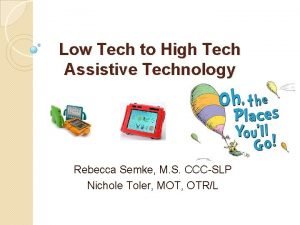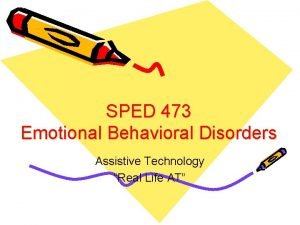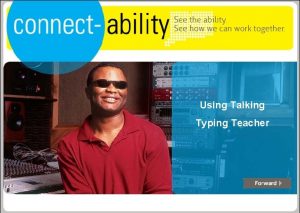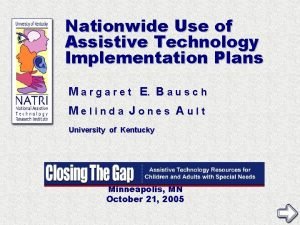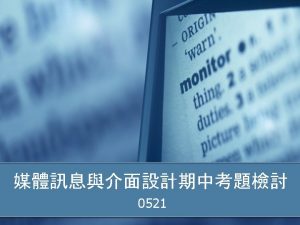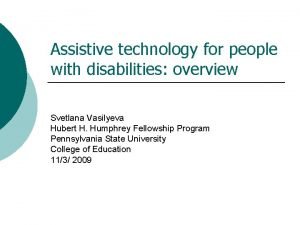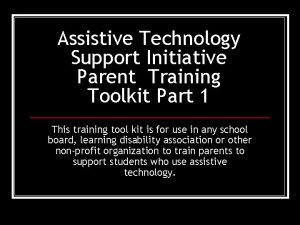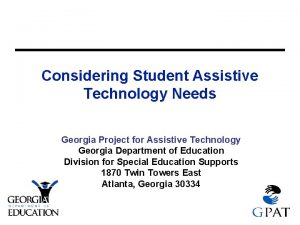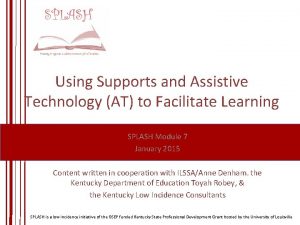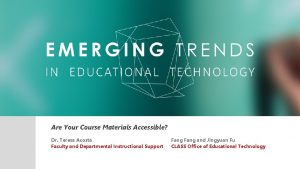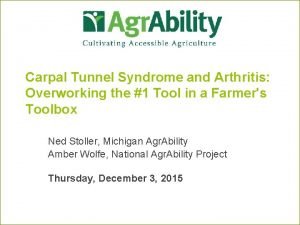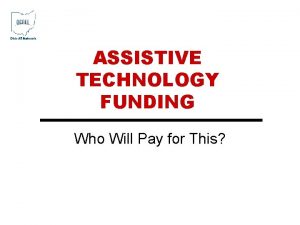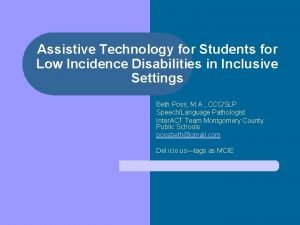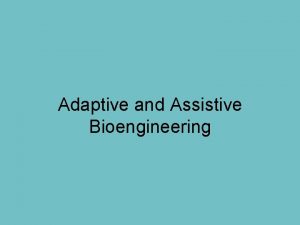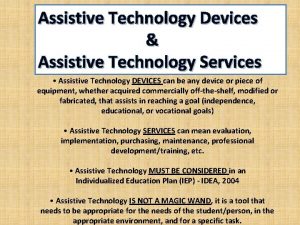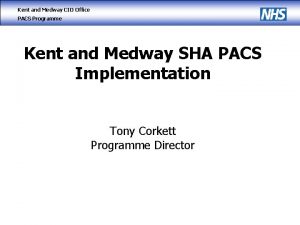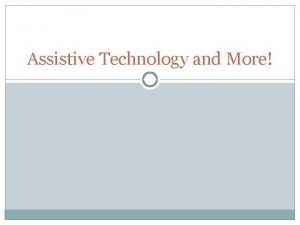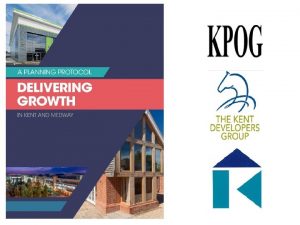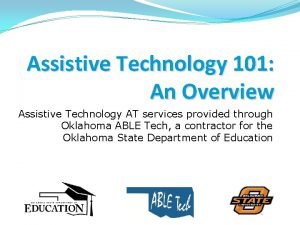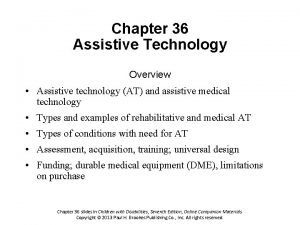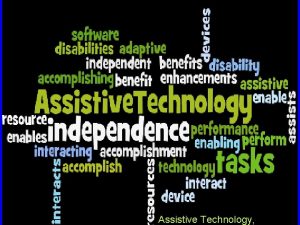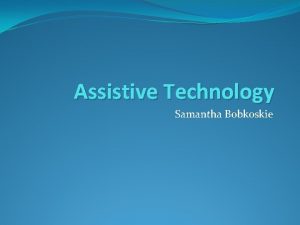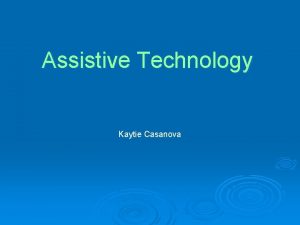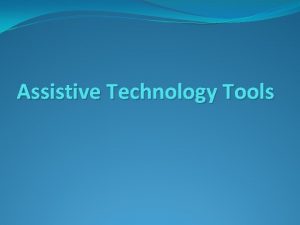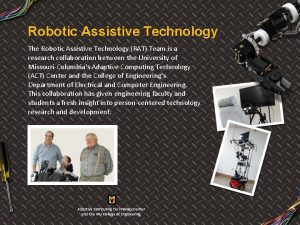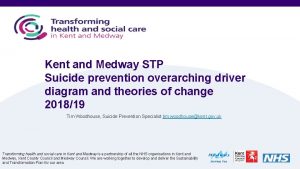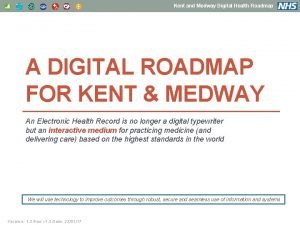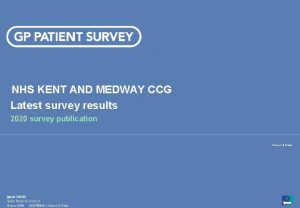Kent and Medway Communication and Assistive Technology KM



















- Slides: 19

Kent and Medway Communication and Assistive Technology (KM CAT) Service

From the beginning: • CAP Project • Received full commissioning in 2007 to provide two levels of service. • NHS England commissioned 13 AAC Hub Services in 2014 with specific criteria for referral. • Also funded by local CCGs for “Spoke Support” as well as Social Care and Local Education Authority. • Trans-disciplinary and collaborative multi-agency working.

NHS England National Criteria An individual who would access a specialist AAC service would: • Have a severe or complex communication difficulty associated with a range of physical, cognitive, learning or sensory deficits. • Have a clear discrepancy between their level of understanding and ability to speak. • Be able to understand the purpose of a communication aid. • Have developed beyond cause and effect understanding. And may: • Have experience of using a low tech AAC device which is insufficient to enable them to realise their communicative potential.

NHS England National Criteria 4. 7 In a person with developing AAC skills the following factors will apply: 4. 7. 1 The person should be able to consistently make purposeful choices. Evidence of this will be required. 4. 7. 2 The referring therapist should evidence that the person is moving beyond basic choice making and would now benefit from the use of technology in order to communicate a larger variety choices for increased communicative functions e. g. to make requests, question, comment, interact etc. 4. 7. 3 The person should demonstrate ability to link ideas/ semantic categories and syntactic functions beyond basic requests.

NHS England National Criteria 4. 8 In addition, where identified impairments of social communication are present, consideration should be given to how these impairments would impact on the functional use of an AAC system. The following factors should apply: 4. 8. 1 As with other groups, provision of a system should look to broaden the range of communicative functions and contexts in which a person can participate. 4. 8. 2 In common with other areas of this pathway, examples of low-tech use and why this is not suitable or not sufficient to meet the communication needs of the person would need to be provided.

NHS England National Criteria 4. 8. 3 Communicative intent would need to be demonstrated, as this funding stream is not intended to cover devices provided for the purposes of language modelling, behaviour management and the development of social interaction skills. 4. 9 In most circumstances, a referral should indicate that low-tech AAC has been considered and must identify why this does not meet the person’s needs. A case for why a VOCA might better meet their needs should be presented. If low tech AAC has not been considered, the referral should justify why this is the case.

Additional provision for Kent The Kent and Medway CAT Service is jointly commissioned to support children and young people with Special Educational Needs (SEN) who have complex written communication difficulties. For this reason our criteria can also include children and young people who: • Have complex physical difficulties which mean standard methods of accessing computers are not effective and appropriate and require a specialist approach. • Require advice, for example, regarding their progression in Assistive Technology (AT) use where appropriate curriculum software and alternative computer access devices have been trialled and evaluated. • Require involvement to introduce technologies associated with alternative means of recording.

KM CAT referral form is on the KELSI website: www. kelsi. org. uk (Kent Education, Learning and Skills Information) Search for ‘KELSI KM CAT service’

The purpose of The Kent and Medway CAT Service remains: ‘To work in partnership with schools and families to provide communication and assistive technology solutions that enable children and young people to enjoy themselves, develop independence, participate and achieve. ’ The Kent and Medway CAT Service operates a single point of referral system to access the different interventions available from the service.

The KM CAT Service provides: Assessment: A specialist multi-disciplinary approach to an assessment, intervention and review of a child or young person’s AAC/AT needs. The assessment may: • lead to the selection and provision of specialist assistive technology. • lead to a loan to explore effectiveness of a recommended selection of equipment. Assessments may be offered that do not provide equipment. These will: • provide the Kent and Medway CAT Service staff with an opportunity to explore complex communication in more detail. • not lead to provision at that particular time in the child or young person’s development.

The KM CAT Service provides: Consultation: The Kent and Medway CAT Service offer a consultation where involved professionals, school staff and parents attend a meeting in which a multi-disciplinary team from The Kent and Medway CAT Service provides advice and devises a joint action plan. Training: The Kent and Medway CAT Service provides regular training opportunities from The Old Railway School for AAC and AT related knowledge and skills support. Bespoke training relating to AAC and AT strategies in school settings can be requested if there is a need for training to be tailored and delivered specifically for a setting, school or group.

Time to make a referral • This is a time-consuming process. It is important to establish expectations from the start. • The referral should be collaborative between therapists, school and family. • It is worth booking out an intervention session to get together to discuss and complete the referral. You have your manager’s permission to do so

KM CAT Training Offer: • Courses at The Old Railway School: Introduction to AAC; AA Little and Often; AAC in the Classroom; Clicker 7; Focus on Eye Gaze Workshop; Grid 3; Proloquo 2 Go • Bespoke Courses (at ORS, or at Schools or other settings) • Information Days • e-learning Full details can be found on Kelsi website: www. kelsi. org. uk Search for ‘KM CAT service’

E-learning – ‘AAC: Little and Often’

E-learning – ‘AAC: Little and Often’

E-learning – ‘AAC: Little and Often’

E-learning – ‘AAC: Little and Often’ ’AAC: Little and Often’ e -learning module can be accessed on: Kent CPD Online (you will need to create an account) or follow the link from

More E-learning modules to follow: • Developing skills towards using eye gaze technology for communication • Using AAC with children and young people on the autistic spectrum • Teaching literacy to non-verbal children and young people, in order to develop literacy for communication

And finally:
 Low tech and high tech assistive technology
Low tech and high tech assistive technology Assistive technology for emotional and behavioral disorders
Assistive technology for emotional and behavioral disorders Typing assistive technology
Typing assistive technology National assistive technology research institute
National assistive technology research institute Assistive technology wikipedia
Assistive technology wikipedia Meaning of assistive technology
Meaning of assistive technology Audioize
Audioize Illinois assistive technology
Illinois assistive technology Don johnson assistive technology
Don johnson assistive technology Go talk assistive technology
Go talk assistive technology Georgia project for assistive technology
Georgia project for assistive technology Assistive technology toys
Assistive technology toys Assistive technology in classrooms
Assistive technology in classrooms Reading untagged document with assistive technology
Reading untagged document with assistive technology Assistive technology for carpal tunnel syndrome
Assistive technology for carpal tunnel syndrome Assistive technology salary
Assistive technology salary Edudel student module
Edudel student module Medway valley heritage forest
Medway valley heritage forest Big builders medway
Big builders medway Assistive bioengineering examples
Assistive bioengineering examples
